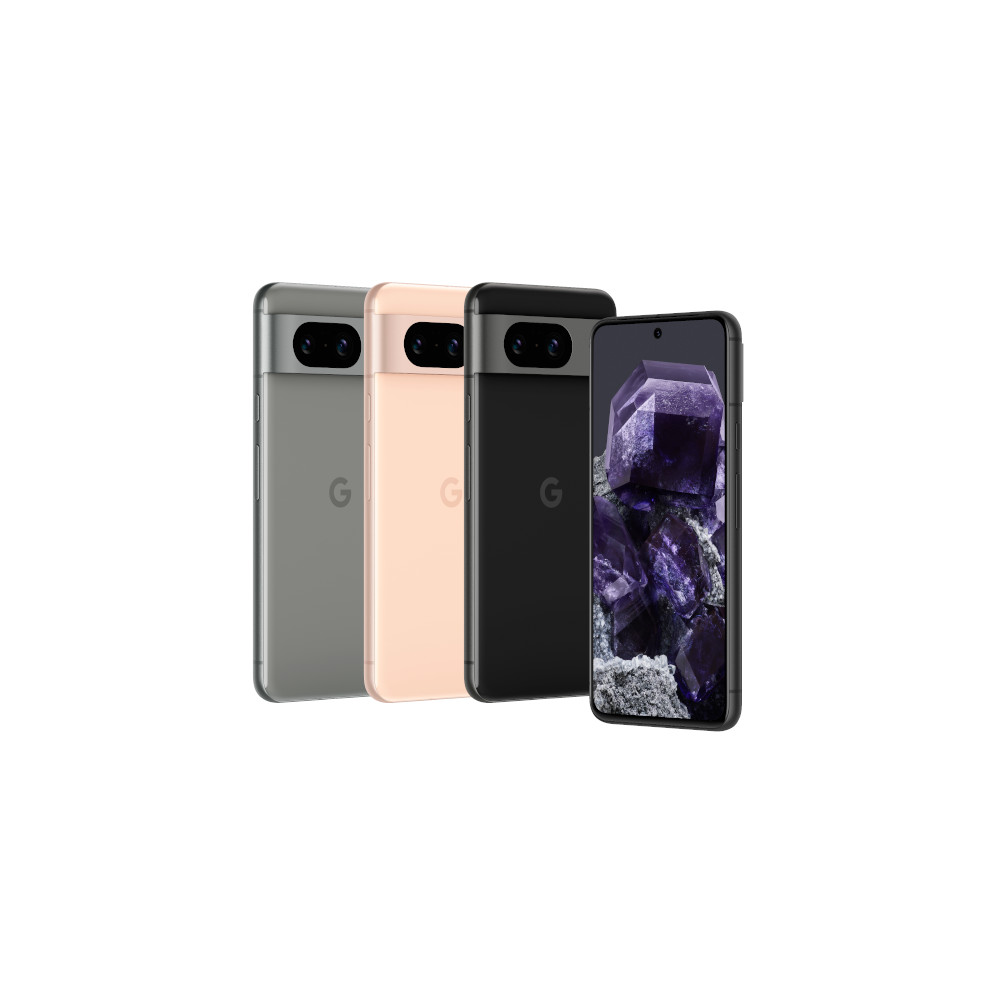Affiliate links on Android Authority may earn us a commission. Learn more.
Google Pixel 7a vs Pixel 8: Should you upgrade?
Published onJanuary 31, 2024
The Pixel 7a is a very recent phone, but it’s still technically a part of Google’s last-generation hardware now that the Pixel 8 is on shelves. If you were an early adopter of the 7a, you might even be considering an upgrade to access all of the latest bells and whistles. So is it worth trading in that phone and paying the difference?
Google Pixel 7a vs Pixel 8: At a glance
- The Pixel 7a is intended as a budget-ish smartphone, while the Pixel 8 is Google's latest mid-range model.
- The Pixel 8 sports a faster Tensor G3 processor that's specifically engineered to enhance AI tasks.
- The new phone has an ultra-bright display, and better build quality including Gorilla Glass Victus.
- Megapixel count is reduced on the new phones, but with meaningful enhancements like better low-light shooting and exclusive software-based features.
- The Pixel 8 includes a larger battery, faster wired charging, and support for both reverse and regular Qi wireless.
- Despite differences, the Pixel 7a remains a capable device.
Google Pixel 7a vs Pixel 8: Specs
| Google Pixel 8 | Google Pixel 7a | |
|---|---|---|
Display | Google Pixel 8 6.2-inch OLED 2,400 x 1,080 resolution 428ppi 20:9 aspect ratio 60-120Hz refresh rate 1,400 nits brightness (HDR) 2,000 nits brightness (peak) Gorilla Glass Victus | Google Pixel 7a 6.1-inch OLED 2,400 x 1,080 resolution 20:9 aspect ratio 90Hz refresh rate 429ppi HDR support Gorilla Glass 3 cover |
Processor | Google Pixel 8 Google Tensor G3 | Google Pixel 7a Google Tensor G2 |
RAM | Google Pixel 8 8GB LPDDR5X | Google Pixel 7a 8GB LPDDR5 |
Storage | Google Pixel 8 128 or 256GB UFS 3.1 No microSD card support | Google Pixel 7a 128GB UFS 3.1 No microSD card support |
Power | Google Pixel 8 4,575mAh (typical) 27W wired charging (UDB-PD 3.0 PPS) 12-18W wireless charging Battery Share reverse wireless charging | Google Pixel 7a 4,385mAh battery (typical) 18W wired charging 7.5W wireless charging Battery Share not supported |
Cameras | Google Pixel 8 Rear: - 50MP wide (1.2μm pixel width, ƒ/1.68 aperture, 82-degree FoV, 1/1.31-inch sensor, AF, OIS, EIS) - 12MP ultrawide (1.25μm pixel width, ƒ/2.2 aperture, 125.8-degree FoV, AF) - Single-zone laser-detect auto-focus (LDAF) sensor Front: - 10.5MP (1.22μm pixel width, ƒ/2.2 aperture, 95-degree FoV, FF) | Google Pixel 7a Rear: - 64MP wide primary sensor (0.8μm, ƒ/1.89, 80-degree FoV, 1/1.73" image sensor size, Super Res Zoom up to 8x) - 13MP ultrawide (1.12μm, ƒ/2.2, 120-degree FoV) Front: - 13MP wide (1.12μm, ƒ/2.2, 95-degree FoV) |
Connectivity | Google Pixel 8 US (PR), CA, UK, EU, AU: - Wi-Fi 7 (802.11be) with 2.4GHz, 5GHz, 6GHz - 2x2+2x2 MIMO - NFC - Bluetooth 5.3 JP: - Wi-Fi 6E (802.11ax) with 2.4GHz, 5GHz, 6GHz - 2x2+2x2 MIMO - NFC - Bluetooth 5.3 TW, SG, IN: - Wi-Fi 6 (802.11ax) with 2.4GHz, 5GHz - HE160 MIMO - NFC - Bluetooth 5.3 | Google Pixel 7a All countries: - Dual-SIM (1x nano-SIM + 1x eSIM) - 5G sub6 - Bluetooth 5.3 - NFC US, CA, UK, EU, AU, and JP only: - Wi-Fi 6E (802.11ax) with 2.4GHz + 5GHz + 6GHz TW, SG, and IN only: - Wi-Fi 6 (802.11ax) with 2.4GHz + 5GHz |
Network | Google Pixel 8 Model G9BQD (US and CA) - GSM/EDGE: Quad-band (850, 900, 1800, 1900MHz) - UMTS/HSPA+/HSDPA: Bands 1, 2, 4, 5, 6, 8, 19 - LTE: Bands B1 / 2 / 3 / 4 / 5/ 7 / 8 / 12 / 13 / 14 / 17 / 18 / 19 / 20 / 25 / 26 / 28 / 29 / 30 / 38 / 40 / 41 / 46 / 48 / 66 / 71 - 5G Sub-6: Bands n1 / 2 / 3 / 5 / 7 / 8 / 12 / 20 / 25 / 26 / 28 / 29 / 30 / 38 / 40 / 41 / 48 / 66 / 70 / 71 / 77 / 78 Model GKWS622 (US and CA): - GSM/EDGE: Quad-band (850, 900, 1800, 1900MHz) - UMTS/HSPA+/HSDPA: Bands 1, 2, 4, 5, 6, 8, 19 - LTE: Bands B1 / 2 / 3 / 4 / 5 / 7 / 8 / 12 / 13 / 14 / 17 / 18 / 19 / 20 / 25 / 26 / 28 / 29 / 30 / 38 / 40 / 41 / 46 / 48 / 66 / 71 - 5G Sub-6: Bands n1 / 2 / 3 / 5 / 7 / 8 / 12 / 20 / 25 / 26 / 28 / 29 / 30 / 38 / 40 / 41 / 48 / 66 / 70 / 71 / 77 / 78 - 5G mmWave: Bands n258 / 260 / 261 Model GZPFO (JP): - GSM/EDGE: Quad-band (850, 900, 1800, 1900MHz) - UMTS/HSPA+/HSDPA: Bands 1, 2, 4, 5, 6, 8, 19 - LTE: Bands B1 / 2 / 3 / 4 / 5 / 7 / 8 / 12 / 13 / 14 / 17 / 18 / 19 / 20 / 21 / 25 / 26 / 28 / 30 / 32 / 38 / 39 / 40 / 41 / 42 / 46 / 48 / 66 / 71 - 5G Sub-6: Bands n1 / 2 / 3 / 5 / 7 / 8 / 12 / 20 / 25 / 28 / 30 / 38 / 40 / 41 / 66 / 71 / 75 / 76 / 77 / 78 / 79 - FeliCa Model GPJ41 (All other countries): - GSM/EDGE: Quad-band (850, 900, 1800, 1900MHz) - UMTS/HSPA+/HSDPA: Bands 1, 2, 4, 5, 6, 8, 19 - LTE: Bands B1 / 2 / 3 / 4 / 5 / 7 / 8 / 12 / 13 / 14 / 17 / 18 / 19 / 20 / 25 / 26 / 28 / 30 / 32 / 38 / 40 / 41 / 42 / 46 / 48 / 66 / 71 - 5G Sub-6: Bands n1 / 2 / 3 / 5 / 7 / 8 / 12 / 20 / 25 / 26 / 28 / 30 / 38 / 40 / 41 / 66 / 71 / 75 / 76 / 77 / 78 | Google Pixel 7a Model GWKK3: - GSM/EDGE: Quad-band (850, 900, 1800, 1900 MHz) - UMTS/HSPA+/HSDPA: Bands 1,2,4,5,6,8,19 - LTE: Bands B1/2/3/4/5/7/8/12/13/14/17/20/25/26/28/29/30/38/40/41/48/66/71 - 5G Sub6: Bands n1/2/3/5/7/8/12/14/20/25/28/30/38/41/48/66/71/77/78 Model GHL1X: - GSM/EDGE: Quad-band (850, 900, 1800, 1900 MHz) - UMTS/HSPA+/HSDPA: Bands 1,2,4,5,6,8,19 - LTE: Bands B1/2/3/4/5/7/8/12/17/18/19/20/21/25/28/32/38/39/40/41//42/66 - 5G Sub6: Bands n1/2/3/5/7/8/12/20/25/28/38/40/41/66/75/76/77/78/79 Model G0DZQ: - GSM/EDGE: Quad-band (850, 900, 1800, 1900 MHz) - UMTS/HSPA+/HSDPA: Bands 1,2,4,5,6,8,19 - LTE: Bands B1/2/3/4/5/7/8/12/13/14/17/20/25/26/28/29/30/38/40/41/48/66/71 - 5G Sub6: Bands n1/2/3/5/7/8/12/14/20/25/28/30/38/41/48/66/71/77/78 - 5G mmWave: Bands n260/n261 Model G82U8: - GSM/EDGE: Quad-band (850, 900, 1800, 1900 MHz) - UMTS/HSPA+/HSDPA: Bands 1,2,4,5,6,8,19 - LTE: Bands B1/2/3/4/5/7/8/12/17/18/19/20/21/25/28/32/38/39/40/41//42/66 - 5G Sub6: Bands n1/2/3/5/7/8/12/20/25/28/38/40/41/66/75/76/77/78/79 |
Dimensions and weight | Google Pixel 8 150.5 x 70.8 x 8.9mm 187g | Google Pixel 7a 152 x 72.9 x 9mm 194g |
Software | Google Pixel 8 Android 14 | Google Pixel 7a Android 13 (upgradeable) |
Durability | Google Pixel 8 Gorilla Glass Victus (front and back) IP68 rating | Google Pixel 7a Plastic back Gorilla Glass 3 front IP67 rating |
Ports | Google Pixel 8 USB-C 3.2 Dual-SIM (1x nano-SIM and 1x eSIM) | Google Pixel 7a USB-C 3.2 Single nano-SIM |
There are some tangible differences here, perhaps the most significant being the move from a Tensor G2 processor to the Tensor G3. Aside from general performance improvements, the G3 is intended to boost the AI capabilities Pixel phones are known for. In fact you’ll need a Pixel 8 to exploit some of Google’s latest photo and video options, including Best Take, Magic Editor, and Audio Magic Eraser.
The next change you’ll notice is the display. While the Pixel 8’s screen is only marginally bigger at 6.2 inches, and has the exact same resolution as the 7a, it can get extremely bright — up to 2,000 nits peak, which is more than enough to be clear and legible in direct sunlight. The Pixel 8 also has a dynamic 60-120Hz refresh rate, which allows it to be smoother than the 7a without excessive power consumption.
There are some considerable differences, including processor and display tech.
The Pixel 8 is a tougher phone to boot. Whereas the 7a has an IP67 rating, a plastic back, and Gorilla Glass 3 up front, the 8 improves to IP68 and Gorilla Glass Victus on both the front and the back. That means a more resilient display and better water resistance, though you’ll still want a case, since glass is inherently prone to cracking in hard falls.
Also significant are the Pixel 8’s cameras, battery, and charging tech. We’ll cover those in-depth in a moment. For now we’ll point out that only the Pixel 8 has 256GB storage option, as well as dual-SIM technology, allowing you to use a nano-SIM and/or eSIM. If you’re on the cutting edge of wireless tech, some models support Wi-Fi 7, depending on the country where you buy them. Even Wi-Fi 6E hasn’t been widely adopted yet, so don’t worry about that too much.
Google Pixel 7a vs Pixel 8: Design and size comparison
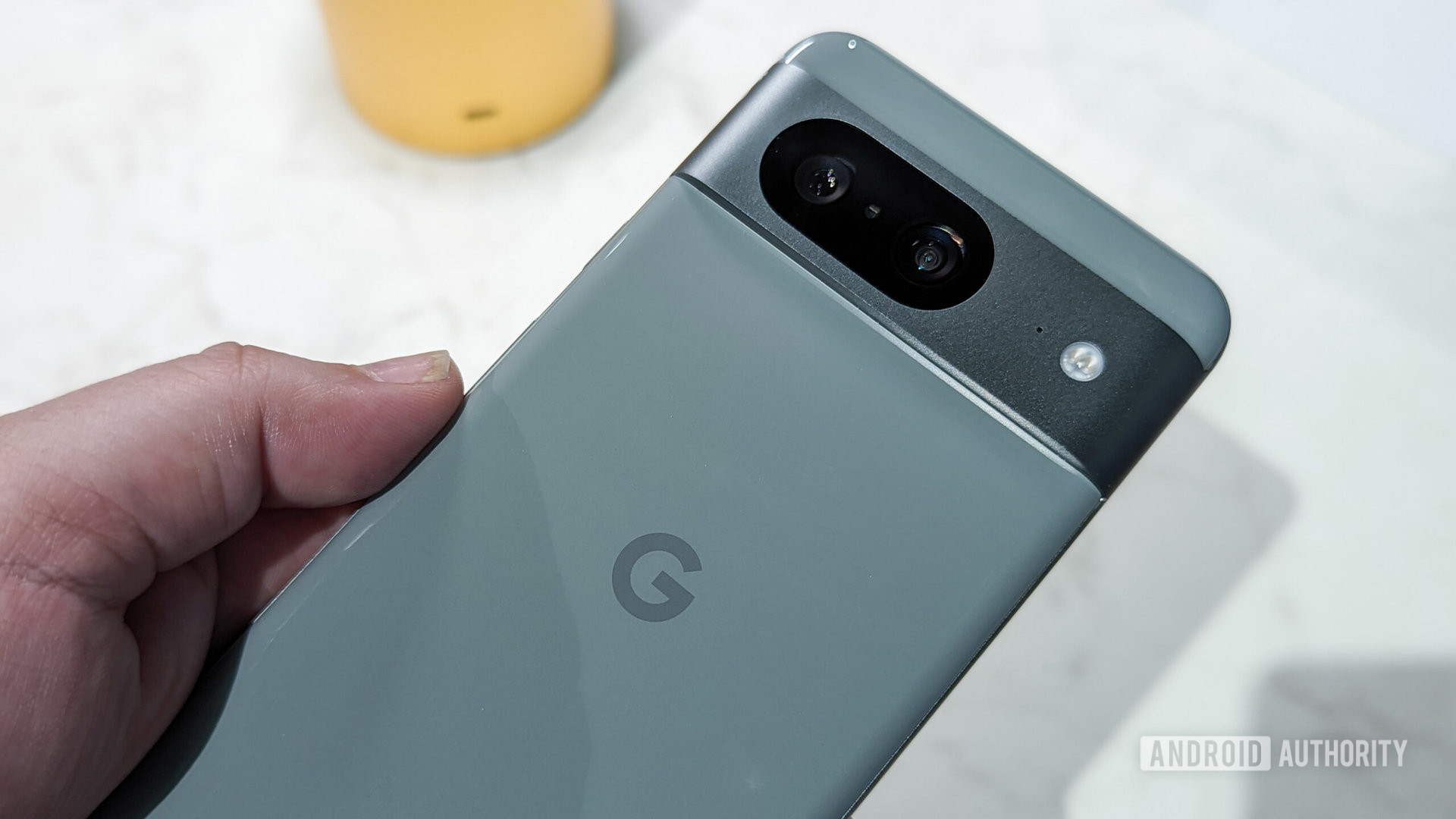
We’ve already mentioned the Pixel 8’s tougher construction and slightly larger display, but apart from that, the phones are extremely similar. They’re both based on the design cues of the Pixel 7, including the rear camera bar, and at a quick glance you might even have a tough time telling the three phones apart. The Pixel 8 (above) is a little smaller and lighter than the 7a, but not enough to matter.
There are a few visible differences, including a more seamless edge on the Pixel 8. The phones also have unique color options — the 7a (below) ships in Charcoal, Sea, Snow, and (more rarely) Coral, but the 8 is available in Obsidian, Hazel, and Rose.
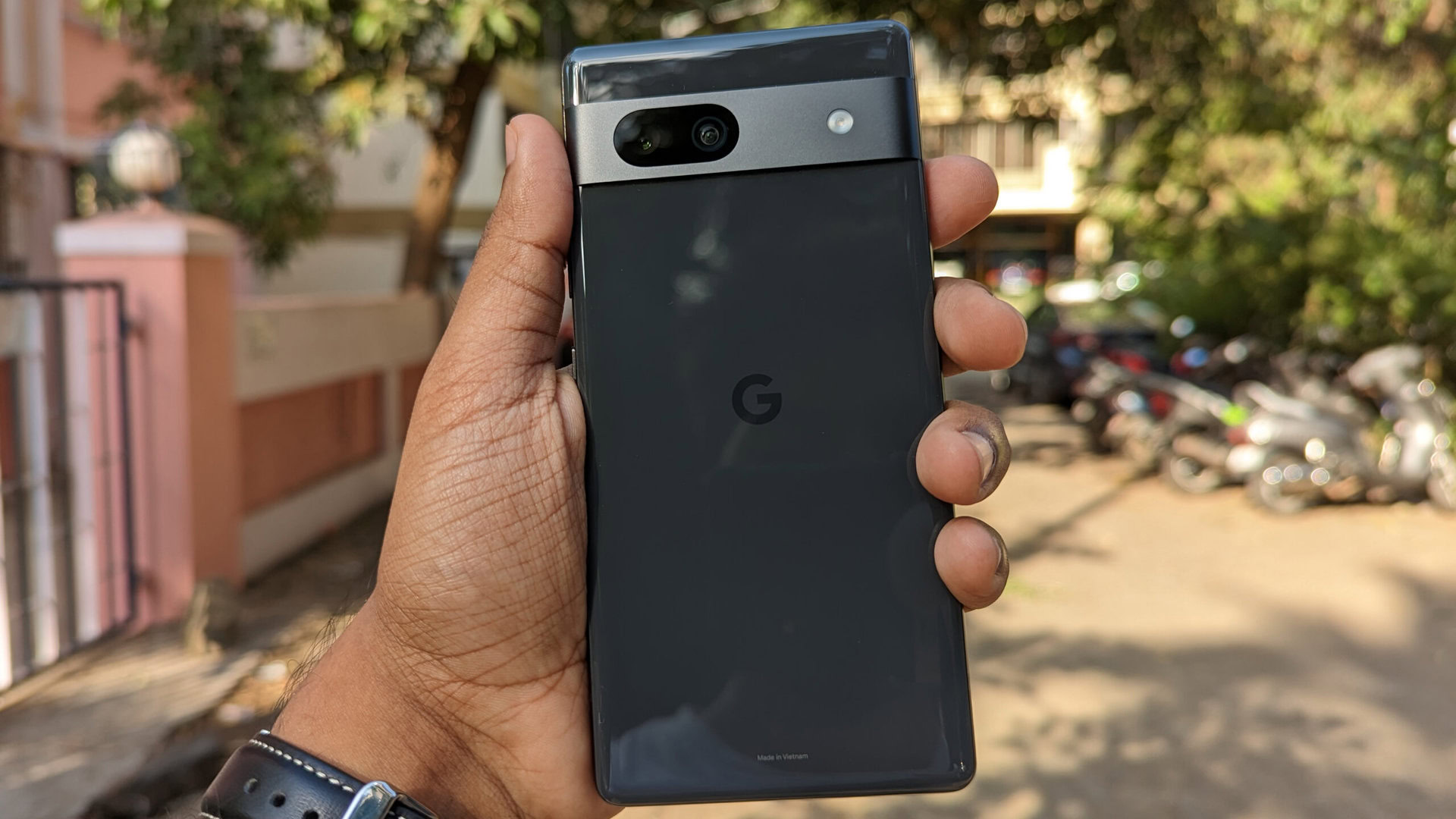
Google Pixel 7a vs Pixel 8: Cameras
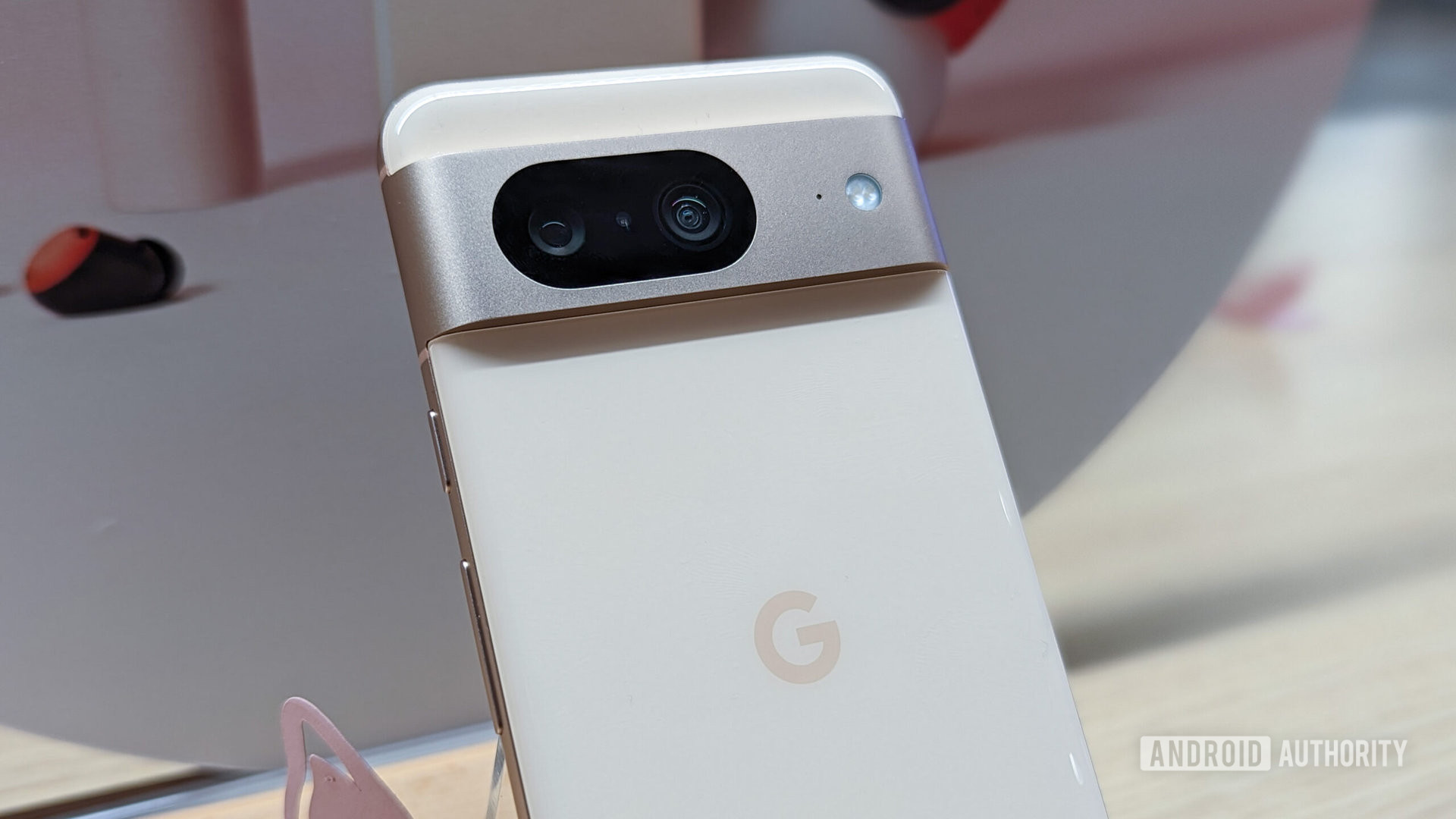
You’ll want to check out our Pixel 8 review for samples, but here we can say that while the while the phone technically has reduced megapixel counts, you’re getting better camera tech overall. Its sensors use wider pixels, which should help with low-light sensitivity and noise, and both of the rear cameras benefit from laser-detect auto-focus. Distinct video capabilities include things like a Macro Focus mode and Cinematic Blur, although both phones can shoot up to 4K at 60fps on their main (wide-angle) cameras.
The 7a isn’t a slouch, as you can tell from our photo samples below. It still supports many of the same software features as the Pixel 8, such as Magic Eraser, Face Unblur, and Real Tone, even if (as mentioned) options like Magic Editor require the newer hardware. We’d only consider the Pixel 8’s cameras a major reason to upgrade if you demand better low-light shooting, or specific software features Google isn’t planning to port back to the 7a.
Google Pixel 7a vs Pixel 8: Battery life and charging
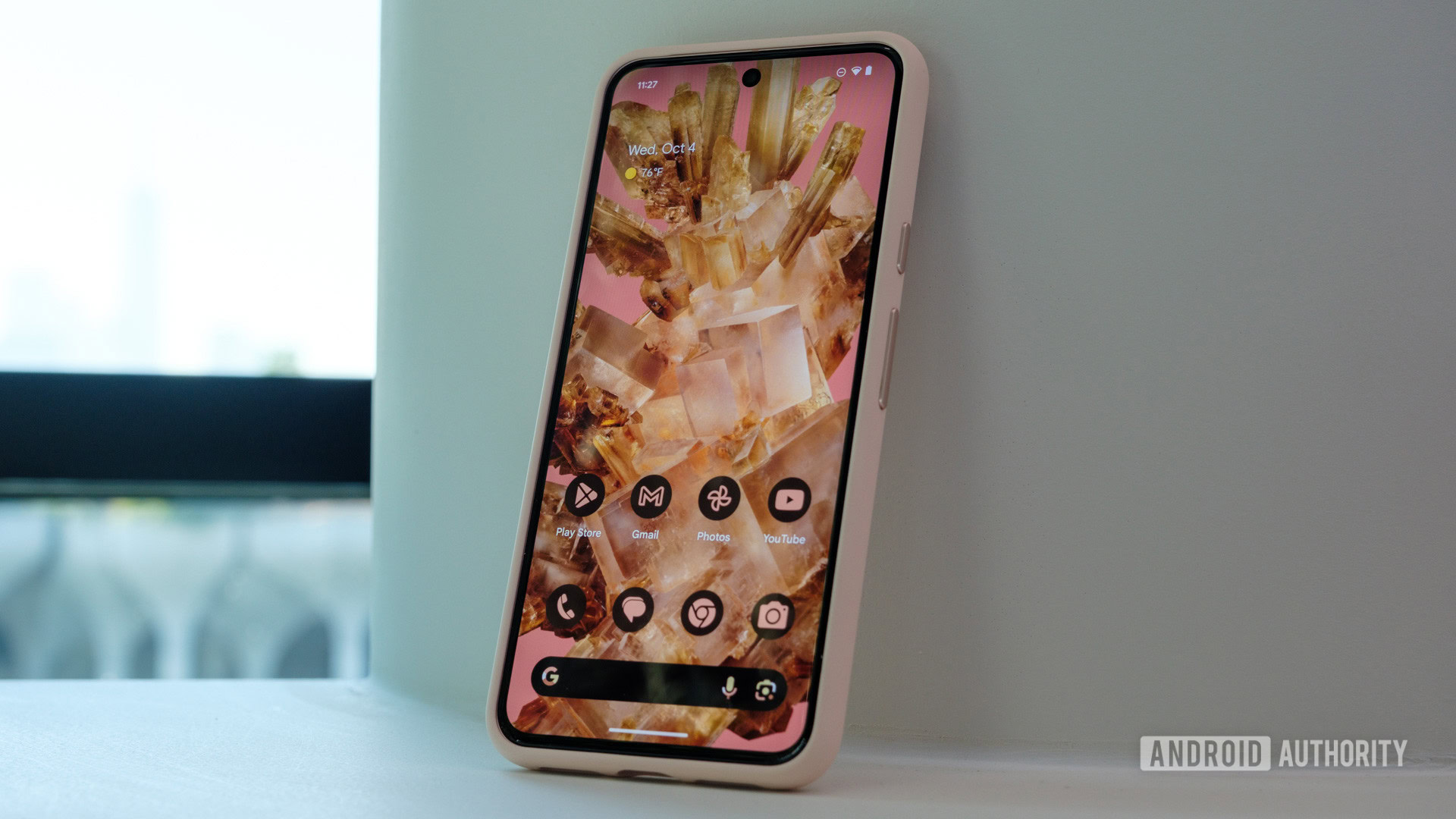
The Pixel 8 is equipped with a larger 4,575mAh battery, so you can expect a boost over the 7a’s mediocre runtime. That should be helped by a dynamic refresh rate and optimizations in Google’s Tensor design. You should still plan to charge every night, and possibly top-up midday if you engage in any heavy video or gaming sessions. Phone makers continue to prioritize display and speed enhancements over battery life, for better and worse.
The Pixel 8 also benefits from 27W wired charging. That isn’t spectacular by current smartphone standards, but it’s better than the 18W cap on the 7a, which happens to be what the 8 can achieve wirelessly when paired with a 2nd gen Pixel Stand. The 8’s wireless capacity does shrink to 12W with other Qi chargers, yet even that’s blazing fast next to the 7a’s 7.5W. If you regularly find yourself frustrated with the 7a’s slow refills, this could be an incentive to switch.
Note also that the Pixel 8 supports Google’s Battery Share reverse wireless, which is missing entirely on the 7a. That feature may be unimportant to most people, yet it can be lifesaver if a partner’s phone or your earbuds are on their last legs.
Google Pixel 7a vs Pixel 8: Price and availability
- Google Pixel 7a (128GB): $499
- Google Pixel 8 (128GB): $699
- Google Pixel 8 (256GB): $759
Here of course is the main drawback to getting a Pixel 8. Even the cheapest model is $699, which may be a good deal for its associated specs, but that’s still $200 more than a 7a. $499 is already stretching the definition of an affordable smartphone for many shoppers, and if you’re among them, you might consider the the Pixel 8 a bridge too far.
The Pixel 7a first launched in May 2023. The Pixel 8 shipped in October the same year, and is now available in Austria, Australia, Belgium, Canada, Denmark, Ireland, France, Germany, Italy, Japan, the Netherlands, Norway, Portugal, Singapore, Spain, Sweden, Switzerland, Taiwan, the United Kingdom, and the United States (except Puerto Rico).
Google Pixel 7a vs Pixel 8: Should you upgrade?
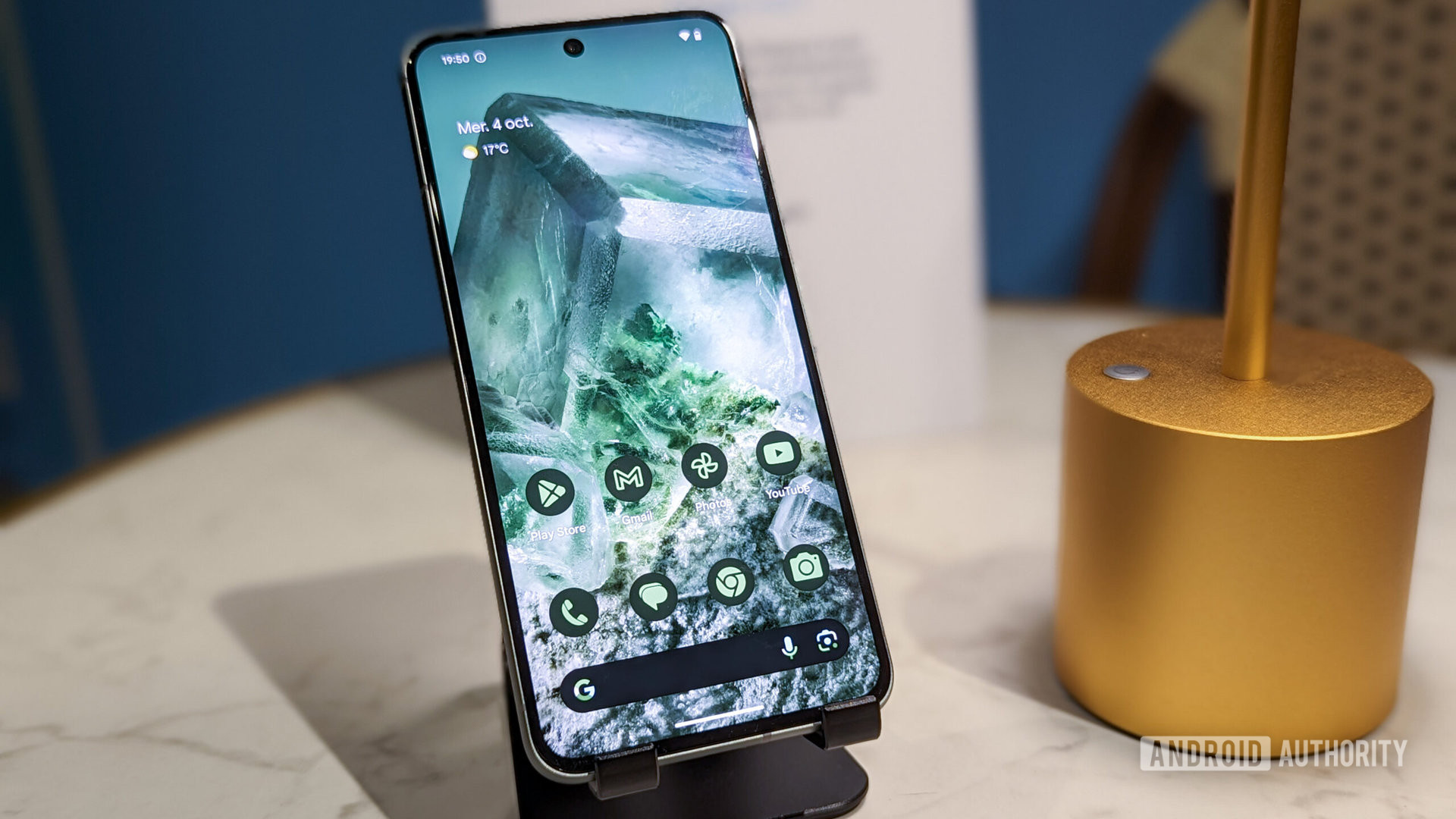
Honestly, probably not. The 7a is less than a year old as of this writing, and if you bought one, it’s likely because you were trying to save cash while getting most of the Pixel 7’s core features. If you want to upgrade your Pixel without putting a major dent in your budget, you’re better off waiting for a possible Pixel 8a in 2024, or perhaps a 9a or 10a.
The upgrade could be worth it if you’ve been using the 7a for a while and you’re find it more limiting than you expected. Its battery life and charging speeds leave something to be desired, after all, and there may be something specifically appealing about the Pixel 8’s camera tech, whether it’s superior low-light shooting or an AI-based photo or video feature. Heck, you might work in the outdoor sun often enough that the 8’s display could save a lot of eyestrain.
Are you upgrading from the Pixel 7a to the Pixel 8?
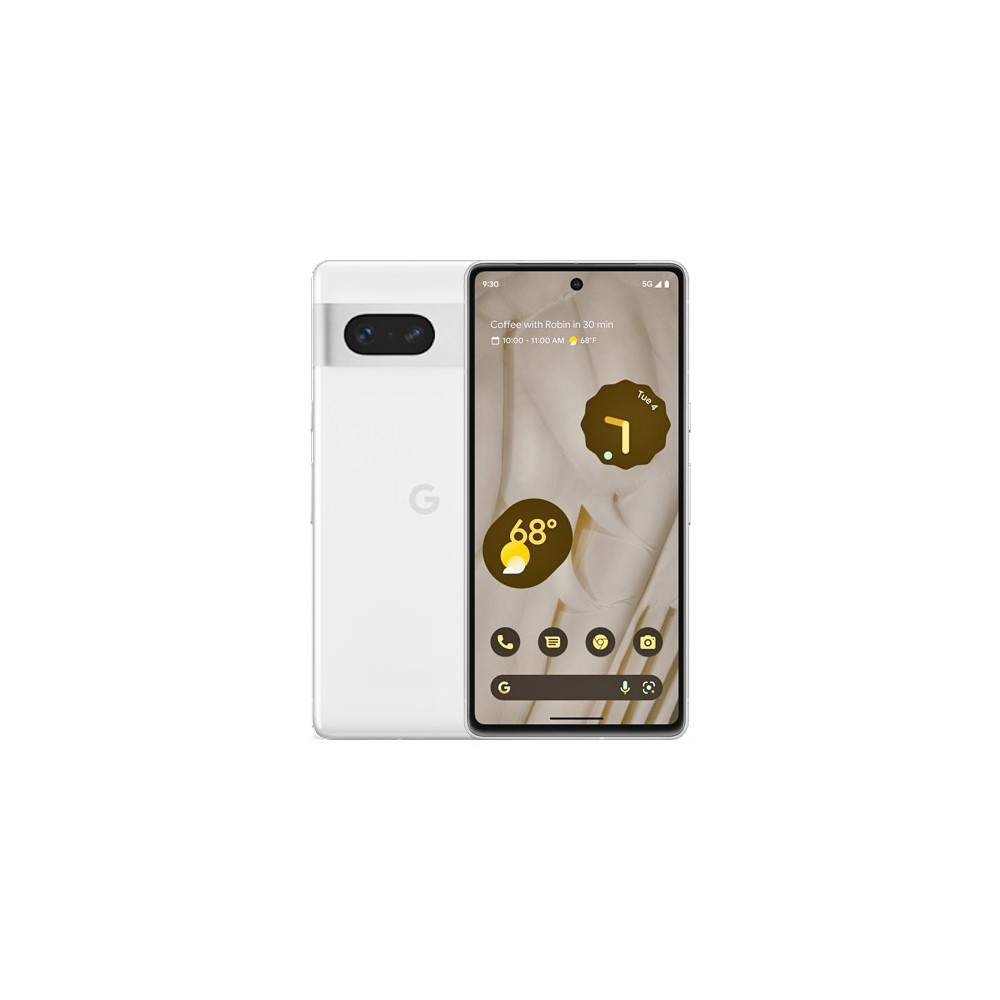
Solid performance and plenty of RAM
Improved 90Hz display
Google Pixel 7a vs Pixel 8: FAQ
Yes. The Pixel 8 can charge up to 18W when paired with a 2nd gen Pixel Stand, or 12W when using a conventional Qi charger. The 7a is limited to 7.5W, and doesn’t support Battery Share reverse charging like the 8.
Yes, to a degree. The Pixel 7a has an IP67 water resistance rating, while the 8 has a slightly better IP68 classification. Neither device should follow you swimming or in the shower, at least not without a water-sealed case, and you should dry off the outside of your phone after any liquid exposure. Avoid salt water or chlorine.
The Pixel 7a first shipped in May 2023. The Pixel 8 arrived a few months later, in October.
No, neither phone has a 3.5mm headphone jack. You’re expected to use Bluetooth or USB-C headphones, though you may be able to bridge the gap with a USB-C-to-3.5mm adapter.
The Pixel 7a is limited to a single nano-SIM slot. The standard Pixel 7 combines that with eSIM support.
